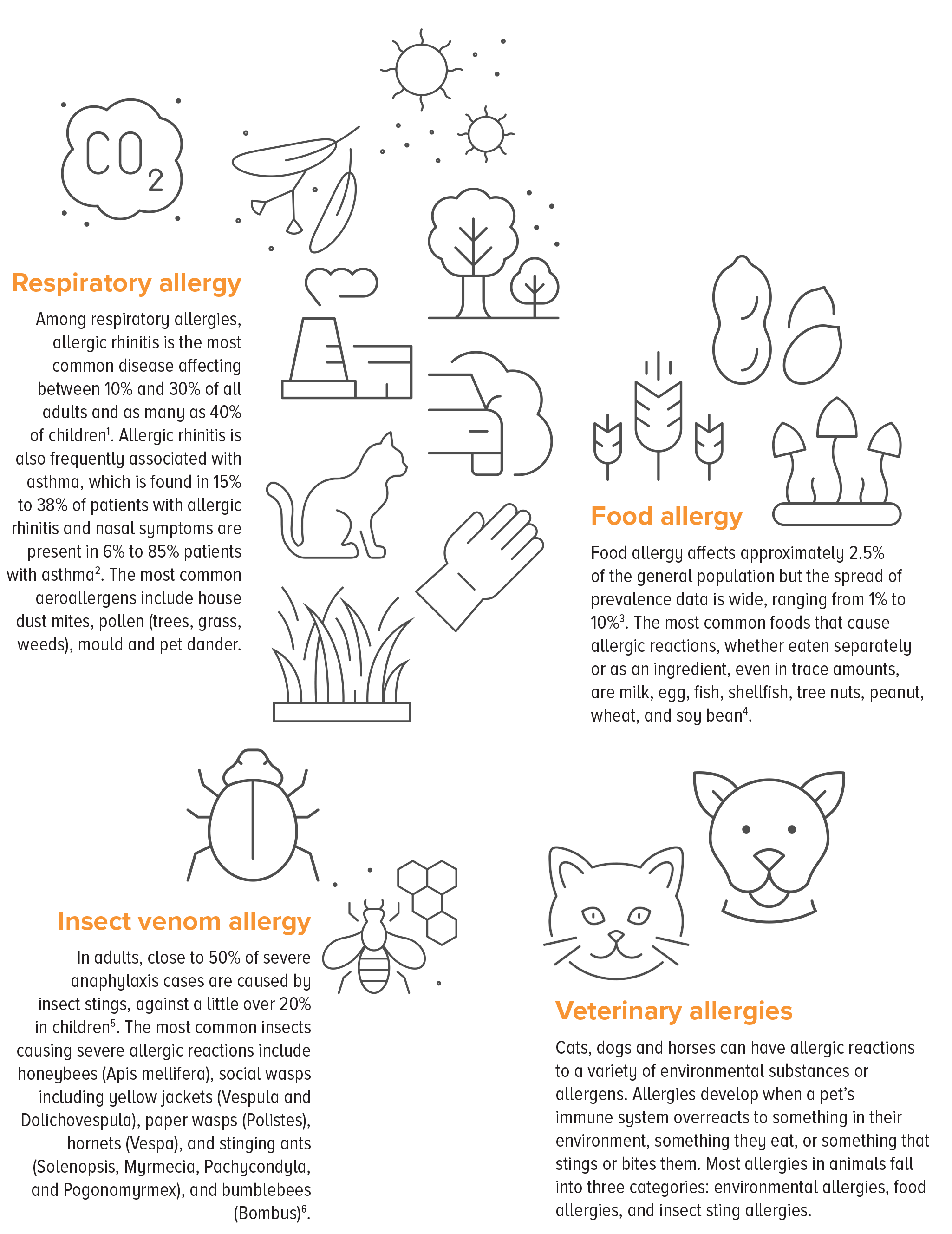Allergens and AIT
About allergens and allergen immunotherapy
Allergy is a disorder of the immune system which reacts to a normally harmless foreign substance such as house dust mites, pollens, or certain foods. In people with allergies, the immune system produces antibodies that identify a particular allergen as harmful following contact, ingestion or even inhalation. The immune system’s reaction can cause inflammation of the eyes, skin, sinuses, respiratory airways, digestive system and may lead to anaphylaxis.

Allergy diagnosis
The diagnosis of respiratory allergies is based on clinical history, physical examination, allergy tests and specific questions. Two diagnostic methods are available to identify the triggering allergens in individuals: prick tests and blood tests. For food allergy, an additional test called an oral food challenge may be performed.
• Prick tests: via a prick to the skin, the individual is exposed to the suspected allergen and monitored. After approximately 20 minutes, the skin is observed for any signs of reaction to one or several of the allergens: redness, swelling, itching.
• Blood tests: allergen blood tests detect allergen-specific antibodies in the blood. Blood test results are available in a few days.
• Oral food challenge1: for food allergies, to help confirm the diagnosis, medical practitioners may perform an oral food challenge. During the oral food challenge, which takes place in a medical setting under medical supervision, the patient is fed gradually increasing amounts of the suspected food in timed intervals. During the feeding, there is a risk of an allergic reaction, which can be severe. Should an allergic reaction occur, the reaction is managed by medical personnel, the allergy is confirmed, and correct advice for management is provided.
Allergen immunotherapy
Allergen immunotherapy (AIT) is an allergy treatment designed to treat the underlying cause of the disease as well as have a long-lasting effect on all symptoms by inducing tolerance in the immune system2.
After an accurate diagnosis of the type of allergy and responsible allergens, patients, in line with their healthcare practitioner’s prescription, receive a targeted treatment. Through the repeated administration of specific allergens to patients, the immune system builds resistance by changing the types and proportions of antibodies (immunoglobulins) and proteins (interleukins) it produces when it is exposed to the allergen. Because it treats the root cause, AIT results in immunologic tolerance, i.e. a decrease in the body’s reaction to an allergen.
An AIT treatment for respiratory or insect venom allergies take a minimum of three years3 to achieve disease modification.
AIT is the only causative treatment with the goal of inducing allergen tolerance in individuals with venom or respiratory allergies4.
For food allergy, oral immunotherapy (OIT) aims to raise the threshold that may trigger an allergic reaction and protect against accidental exposure of the allergen5.
Food avoidance is the only way to prevent an allergic reaction but achieving full avoidance is very difficult. OIT has emerged as an alternative for the desensitisation of patients with food allergy and offers true hope by mitigating the risk of accidental exposure. Food allergen immunotherapy is carried out in a medical setting. People with food allergies should carry an epinephrine auto-injector.
1. Food Allergy Canada. Food allergy basics, Food allergy 101, Diagnosis. Online www.foodallergycanada.ca. Last accessed March 2024. 2. Global Atlas of Allergy, EAACI 2014. 3. Penagos M, Durham S. Long-term efficacy of the sublingual and subcutaneous routes in allergen immunotherapy. Allergy Asthma Proc 2022 43(4):292-298. 4. AIT: New Avenues in Allergen Immunotherapy. www.foodallergycanada.ca. Wofgang Pfützner, Christian Möbs. 5. AAAAI. The current state of oral immunotherapy. Online: https://www.aaaai.org/tools-for-the-public/conditions-library/allergies/the-current-state-of-oral-immunotherapy. Last accessed March 2024


1. WAO White Book on Allergy: Update 2013. R. Pawankar, G.W. Canonica, S. Holgate and R. Lockey. Publisher: World Allergy Organization 2013. 2. Brozek et al. Allergic Rhinitis and its Impact on Asthma (ARIA) guidelines-2016, revision J Allergy Clin Immunol 2017 Vol. 140 Issue 4 Pages 950-958. 3. Bartha I, Almulhem N, Santos AF. Feast for thought: A comprehensive review of food allergy 2021-2023. J Allergy Clin Immunol 2024;153:576-94. 4. FDA. Food allergies. Online: https://www.fda.gov/food/food-labeling-nutrition/food-allergies. Last accessed March 2024. 5. Worm M, Moneret-Vautrin A, Scherer K, Lang R, Fernandez-Rivas M, Cardona V, et al. First European data from the network of severe allergic reactions (NORA). Allergy (2014) 69(10):1397–404. doi: 10.1111/all.12475. 6. World Allergy Organ J. 2019 Oct; 12(10): 100067. Worldwide perspectives on venom allergy. Peter Korošec, Thilo Jakob, Harfi Harb, Robert Heddle, Sarah Karabus, Ricardo de Lima Zollner, Julij Selb, Bernard Yu-Hor Thong, Fares Zaitoun, David B.K. Golden, and Michael Levin.
